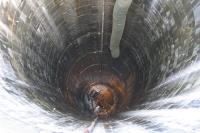Koralm, Graz - Klagenfurt Railway Line, Wettmannstätten - St. Andrä Section
Client: Austrian Railways Infrastructure AG
Development Period: since 1996
With the new Koralm Railway Line between Graz and Klagenfurt, an essential section of the european railway system will be implemented.
Within the 43.8 km long Wettmannstätten - St. Andrä section (the core of the line) the Koralm Tunnel, with a length of 32.8 km, is situated.
The double-tube tunnel cuts through polymetamorphic crystalline rock of the Koralpe and has an overburden of up to 1,200 m. Near the tunnel entrances, tertiary sediments of different grain sizes and rock with minor strength exists. This material has to be crossed over a total length of 8.1 km with an overburden of up to 150 m.
For further exploration, three tunnels (total length of 10.8 km) and two shafts (depth of 120 m and 60 m) were excavated.
BGG was commissioned with the hydrogeological and geotechnical workmanship of the tertiary tunnel sections and open areas. During the planning phases (route selection, environmental impact assessment, and the tender for the exploration structures), the following tasks were carried out:
- Hydrogeological field mapping
- Planning and handling of several subsoil exploration campaigns
- Interpretation of aerial photographs and geophysical investigations
- Numeric hydraulic modelling
- Compilation of geotechnical and hydrogeological expertises
- Geological documentation of the exploration structures during excavation
- Coordination and implementation of the preservation of the hydrogeological evidence
Paierdorf exploration shaft:
For this 120 m deep shaft, that has already been completed, a particularly intensive geological and hydrogeological supervision was essential during the design and execution phases. This was necessary due to the predominant subsoil and groundwater situation: Granular soil, with varying grain sizes, and several groundwater storeys exist all the way to the bottom of the shaft.
Already during the planning stage of the tender, BGG established a detailed system for the lowering of the groundwater of the different groundwater storeys. During excavation, an intensive supervision and control of these groundwater lowering measures, based on geological documentation by own employees, took place. As a result, this structural element was completed without major problems.
July 2005
